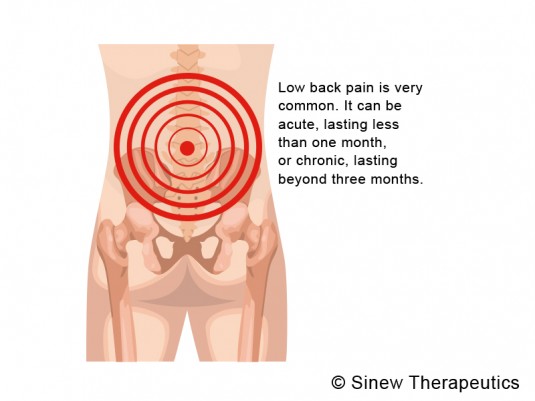Lumbar strains and sprains are common causes of lower back pain. The back functions in bending and turning movements and as a major weight bearer for the body. The core muscles and ligaments of the back are also often a source of power for the arms and legs.


The Difference Between A Lower Back Strain And Sprain
While strain and sprain are often used interchangeably because the pain is difficult to distinguish one from another, it’s important to understand that a lower back muscle strain occurs when muscle fibers are stretched abnormally or torn. A lower back sprain is caused from ligaments, the bands of tissue holding bones together, being damaged or torn.
Lower Back Strain
This injury occurs when a muscle is strained or stretched beyond it’s limit, possibly resulting in tearing. Muscle fibers pull apart and lose the ability to properly contract. The most common cause of lower back strain is overuse or misuse of the lower back muscles in a way that they’re simply not designed for. This may be a single stressful incident, such as lifting something too heavy, or gradually and repetitively engaging in motions that the back isn’t able to handle. How much damage happens determines the severity of injury and damage; a concept described in three grades:
Grade 1 - stretching of a few of the muscle fibers.
Grade 2 - significantly more numbers or degree of muscle fiber damage.
Grade 3 - muscle fibers are torn or ruptured.
Lower Back Sprain
A lower back sprain occurs much like a lower back strain, but it’s the ligament fibers being stretched from overuse or misuse. The grading system for sprain injury is as follows:
Grade 1 - ligament fibers are stretched, but not torn.
Grade 2 - ligament fibers are more drastically stretched and part of the ligament may be partially torn.
Grade 3 - the ligament is completely torn or ruptured.
Symptoms Of Lower Back Strain
* Lower back pain that may radiate to buttocks, but not into legs
* Lower back muscle weakness
* Lower back muscle spasms (especially the first couple of days after an injury)
* Lower back muscle stiffening
* Reduced motion ability
* Lower back inflammation
Symptoms Of Lower Back Sprain
* Minor back pain, swelling, and reduced movement ability (grades 1 and 2)
* Severe back pain, swelling, bruising, reduced movement, and possible muscle spasms (grade 3)
* Pain may gradually worsen over a few days after injury
Causes Of Lower Back Strain and Sprain
Either can be due to a sudden or traumatic injury or from misusing or overusing the ligaments and muscles. Examples of causes would include a sudden or repetitive abnormal or normal movement, twisting movement, car accident, fall, and lifting of heavy items. Essentially, lower back muscles and ligaments can be strained and sprained from any activity that requires bending, stretching, or twisting of the lower back.
Massage Treatment
These Low Back Massage Techniques are of great value in pain relief; circulation stimulation; dispersing blood and fluid accumulations; swelling reduction; and relaxing muscle spasms, especially when used alongside the Sinew Therapeutics liniments and soaks.
ACUTE STAGE SYMPTOMS AND TREATMENT
This stage is characterized by swelling, redness, pain, and possibly a local sensation of heat, indicating inflammation. If coolness makes your pain feel better, then the Acute Stage Treatment is recommended.
ACUTE STAGE SYMPTOMS:
The acute stage starts the moment an injury occurs and lasts until the swelling and inflammation are gone. The swelling is the result of the blockage of blood, tissue fluids and circulation in the back because their normal movement has been disrupted by the force of the injury. Just like cars back up behind a traffic jam, causing congestion, exhaust and overheating; blood and fluids back up behind the injured back, causing pain, inflammation, lumps and swelling.
The sensation of heat is due to the warming action of the blood and fluids overheating in the injured back as they back up and accumulate. Stiffness and decreased mobility are due to spasms in tendons and ligaments that have contracted reflexively beyond their normal range from the impact of the injury.
As ligaments and tendons stretch and tear, blood from ruptured blood vessels becomes trapped in the local tissues. As the trapped blood clots up, it sticks the tissues together creating adhesions. Adhesions cause pain, inflammation and restricted movement because the layers of tissue that used to slide smoothly across one another now adhere and snap which interferes with normal functioning. It is essential to break up clotted blood as quickly as possible to prevent adhesions and scar tissue from forming.
During the acute stage it is very important to restore normal circulation to the back, break up clotted blood and stagnant fluids, reduce swelling, and reduce the redness and heat associated with inflammation. By restoring the flow of blood, fluids, and circulation in the back, then pain is relieved, damaged tissues can regenerate with healthy functional tissue, and the back can strengthen and regain it's mobility.
ACUTE STAGE TREATMENT:
1. Apply the Sinew Herbal Ice on your back to reduce redness, swelling, and inflammation while dispersing accumulated blood and fluids to help restore normal circulation to the back. This first-aid treatment is used in place of ice to significantly speed up the healing process. It reduces the swelling and inflammation more effectively than ice, allowing you to more quickly regain range of motion. Acute Sinew Liniment can be used in-between applications.
Ice is not recommended because it does not help repair damaged tissues and keeps everything in the injured area frozen, causing the stagnation of blood and fluids and the contraction of muscles, tendons and ligaments. In Chinese sports medicine ice is not used and is considered a culprit in injuries that donít heal well.
2. Massage your back with Acute Sinew Liniment to relieve pain, reduce swelling and inflammation, break up clotted blood and stagnant fluids, and stimulate circulation of blood and fluids to help cells quickly repair damaged tissues. Sinew Herbal Ice can be used in-between applications.
3. The Sinew Sports Massage Oil is recommended for use before and after exercise, sports and strenuous activity. It warms and stimulates your muscles, increases circulation and relieves tightness, hence improving your performance and helping to prevent injury.
CHRONIC STAGE SYMPTOMS AND TREATMENT
This stage begins once the swelling and inflammation are gone, but you still feel pain, stiffness, weakness, and/or sensitivity in cold and damp weather. If heat makes your pain feel better, then the Chronic Stage Treatment is recommended.
CHRONIC STAGE SYMPTOMS:
The chronic stage begins once the swelling and inflammation are gone, but you still feel aching pain and stiffness. This is because there are still accumulations of stagnant blood and fluids in your back that are blocking circulation and blood supply to damaged tissues, creating residual pain, stiffness and weakness. You may actually feel hard nodules like sand in the tissue, indicating accumulation, calcification, and adhesions, which all cause pain, stiffness, and joint instability.
Your back may feel more sensitive to the cold and ache in cold and damp weather due to impaired circulation. When you move your back you may hear a clicking or popping sound from the tendons and ligaments slipping very slightly in and out of their natural alignment indicating weakness and joint instability, causing chronic pain and a cycle of reinjury. These symptoms are often the result of failure to treat the injury properly from the outset and overicing.
Increasing circulation and blood supply to the damaged tissues is very important in treating chronic injuries because tendons and ligaments do not have an extensive direct supply of blood. That is why chronic injuries can be slow to heal. Increasing local circulation also prevents cold and dampness from penetrating the injured area, preventing pain and stiffness.
During the chronic stage it is very important to break up remaining accumulations of blood and fluids, and increase circulation and blood supply to the damaged tissues. By increasing circulation and blood flow in the back, then pain and stiffness is relieved, and the tendons and ligaments can strengthen to restore stability.
CHRONIC STAGE TREATMENT:
1. Massage your back with Chronic Sinew Liniment to relieve pain and stiffness, strongly stimulate circulation and blood flow to damaged tissues, and promote the healing of overstretched tendons and ligaments. The Sinew Relaxing Soak can be used in-between applications.
2. Soak your back with the Sinew Relaxing Soak to relax muscles and tendons that are in spasm, ease joint pain and stiffness, and improve range of motion. The Sinew Relaxing Soak is particularly useful if you feel restricted mobility in your back. The soak can be used by saturating a towel in the liquid and applying it to your back. Chronic Sinew Liniment can be used in-between applications.
3. The Sinew Sports Massage Oil is recommended for use before and after exercise, sports and strenuous activity. It warms and stimulates your muscles, increases circulation and relieves tightness, hence improving your performance and helping to prevent injury.








